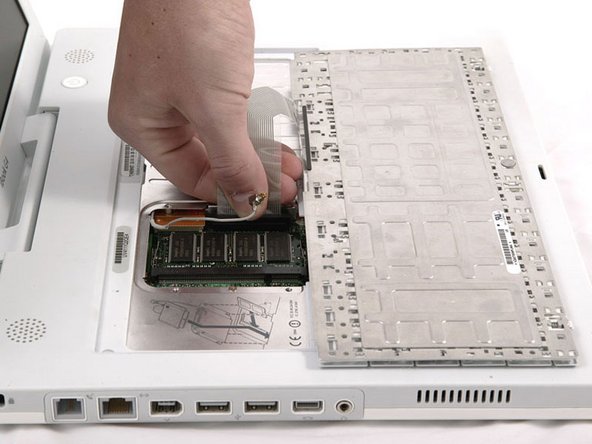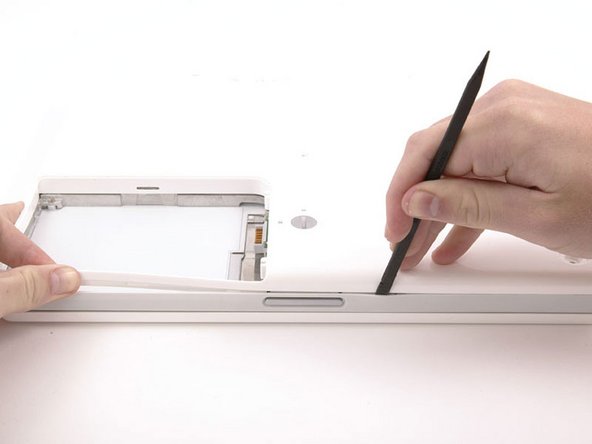iBook G4 14" 933 MHz-1.33 GHz Fan (933 - 1.2 GHz) Replacement
ID: 196
Description: Guide for 933 MHz through 1.2 GHz models....
Steps:
- Use a coin to rotate the battery locking screw 90 degrees clockwise.
- Lift the battery out of the computer.
- Pull the keyboard release tabs toward you and lift up on the keyboard until it pops free.
- If the keyboard does not come free, use a small flathead screwdriver to turn the keyboard locking screw 180 degrees in either direction and try again. The locking screw is in between the F5 and F6 keys and is a clear piece of plastic.
- Flip the keyboard over, away from the screen, and rest it face-down on the trackpad area.
- If the computer has an AirPort card installed, follow the next three steps to remove it.
- Push the wire clasp away from the AirPort card and toward the display, then rotate up to free it from the RAM shield.
- Grasp the clear plastic tab on the AirPort card and pull toward the display.
- Hold the AirPort card in one hand and use your other hand to remove the antenna cable.
- Remove the four silver Phillips screws that secure the RAM shield.
- Grasp the metal bracket on top of the RAM shield and pull upward to remove the shield.
- Pull the keyboard cable up from the logic board, holding the cable as close to the connector as possible.
- Make sure that you reconnect the keyboard cable before replacing the RAM shield.
- Use a pin (or anything you like) to remove the three rubber feet from the lower case.
- Remove the three newly-revealed Phillips screws.
- Use a spudger or small flathead screwdriver to pry up the three metal rings that housed the rubber bumpers.
- Remove the three hex screws using a T8 Torx screwdriver (or Allen screws using an Allen key if these are used).
- The shorter screw is in the center of the computer.
- Remove the two Phillips screws on either side of the battery contacts.
- Breathe deeply. Trying times are ahead, but we promise the lower case does come off.
- Push the thin rims of the lower case surrounding the battery compartment in, bending them past the tabs, and then lift up to free that corner of the lower case.
- There is a slot on the wall of the battery compartment that locks the lower case in place. Use a small flathead screwdriver to pry out the slot's lower rim and pull up on the lower case to free the slot from the tabs holding it.
- Be careful not to break this clip!
- Run a spudger along the seam between the lower case and upper case on the front of the computer to free the tabs locking the lower case. Pull up on the lower case and continue to use the spudger as necessary until you hear three distinct clicks.
- Continue to run the spudger around the front, right corner. There are two tabs on the port side of the computer, one near the front corner and one near the sound-out port.
- There are three tabs over the optical drive that must be released before the lower case can come off. Slide the spudger into the lower case above the optical drive and run it toward the back of the computer until you hear three distinct clicks.
- Once the front and sides of the lower case are free, turn the computer so that the back is facing you and pull the lower case up and toward you until the back tabs pop free (it may be helpful to jiggle the case up and down).
- Remove the small greasy springs with white plastic caps from either side of the battery contacts.
- Remove the following 10 screws from the bottom shield:
- Six 3 mm Phillips
- Three 7.5 mm Phillips
- One 14 mm Phillips
- Lift the bottom shield off.
- Remove the single Phillips screw securing the DC-In board.
- Disconnect the DC-In cable from the logic board.
- Deroute the cable from around the optical drive, removing tape as necessary, and angle the DC-In board out of its compartment.
- Remove the following 11 screws from the bottom of the computer:
- Three 3 mm Phillips around the battery compartment. (Some models may only have two screws.)
- Three 4.5 mm Phillips along the optical drive bezel. (a magnetic screwdriver may help to lift these screws out)
- One 11 mm Phillips in the lower right corner. (if present)
- Four 14.5 mm Phillips.
- We recommend placing the computer on a soft cloth from this point on to prevent damaging the logic board.
- Turn over the computer and open it.
- Remove the 2 Phillips screws (3mm) from the edges of the keyboard area.
- Remove the 4 mm Phillips screw from the lower left corner.
- Before you can yank the upper case off, you must disconnect the trackpad connector, the blue and white power cable, and speaker cable as described in the next steps. Be especially careful with these cables; never pull directly on the cables, but use a spudger to pry up the connector directly.
- Lift the upper case and use a spudger or your finger to disconnect the trackpad connector hidden beneath the white plastic tab. Due to model variatons your trackpad connector may be different than the one pictured.
- Carefully lift the upper case about half of an inch and move it so that you can access the power and speaker cables.
- The connectors at the ends of the cables are attached very firmly to the sockets on the logic board. Pulling directly on the cable will either separate the cable from its connector or the socket from the logic board.
- Lift the upper case enough to disconnect the blue and white power cable from the logic board. Using your fingernails or a dental pick, carefully pry the connector from its socket. Make sure you're pulling only on the connector and not on the socket.
- Carefully disconnect the multicolored speaker cable from the logic board. As before, make sure you're pulling only on the connector and not on the socket.
- The screw circled in orange may not be present in some models.
- Remove the following 16 screws:
- Thirteen 3 mm Phillips.
- One 3 mm Phillips. (actual screw not present in image)
- Two 4 mm Phillips.
- Be sure to fit the screw near the left hinge through the loop in the display data cable, securing the cable to the upper case.
- Missing in this photo is the Bluetooth antenna present in some iBooks. It is located at the upper right corner of the battery compartment, just above the 4mm screw. You can see the bracket for the antenna in the photo. It is the two I-shaped holes just above the 4mm screw that must be removed in this step. To remove the antenna, slide it toward the LCD, and tilt it vertically back towards yourself.
- Lift the top shield up from the right side, minding the upper left corner, which may catch on the metal framework.
- If your iBook has Bluetooth, as discussed in the previous step, you will need to slide the antenna through the lower I-shaped hole in the shield before completely removing the shield.
- Due to variations between iBook G4 models, your modem may look slightly different from the picture. All of the following steps apply to either model.
- Remove the two Phillips screws at the corners of the modem.
- Lift the modem and modem shield from the bottom.
- Disconnect the RJ-11 cable from the top of the modem.
- When replacing the modem, first make sure that both the microphone and display data cables are routed beneath where the modem lies.
- Turn the computer over and disconnect the fan cable from the logic board.
- If present, remove the 4 Phillips screws securing the fan to the metal framework (one screw is hidden by the hand in the image) and lift the fan out of the computer. If no screws are present, continue on.
- Turn the computer over and remove the two Phillips screws from the white plastic fingers of the hinge grill.
- The longer screw goes on the left (Laptop's right) side.
- Due to variations between iBook G4 models, your heatsink may have either 5 or 6 screws. We've noted all possible positions for screws in the step below. If there's no screw to remove, then skip to the next screw. Be sure that you remove all necessary screws before attempting to remove the heat sink.
- Remove the following 6 screws and 3 nuts from the heat sink:
- One 2 mm Phillips extending from a finger on the left edge of the heatsink and adjacent the firewire port (not present on some models)
- Three 3 mm Phillips from around the fan (some models may only have 2 screws).
- One 3.5 mm Phillips on the left side of the heat sink (not present on some models).
- One 4.5 mm Phillips at the top right corner of the heat sink.
- One 6 mm Phillips at the lower left corner of the heat sink.
- One 4 mm nut from the right side of the heat sink.
- Two 4 mm screw nuts with attached springs from either side of the heat sink.
- It may be necessary to soften the thermal paste between the logic board and heat sink. You can soften the thermal compound using a hairdryer. Move the hairdryer back and forth over the ribbed metal section of the heat sink for one minute. At this point, the heat sink should come free easily.
- Use a spudger to pry the heat sink up on the left side, near the hard drive.
- Grasp the heat sink in one hand and lift up the hinge grill in the other hand so that you can remove the heat sink from the computer.
- If you need to mount the heat sink back into the laptop, we have a thermal paste guide that makes replacing the thermal compound easy.
- Remove the 4 Phillips screws securing the fan to the heatsink.
- Lift the fan off of the heatsink.










































